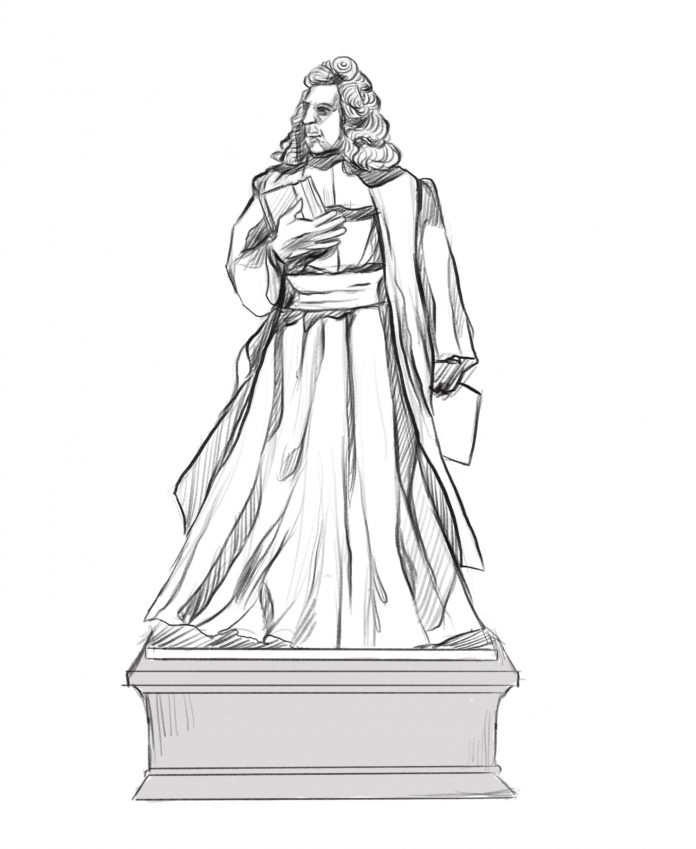Julian Allison is a senior majoring in Government and History. He is the public relations chair for the Committee for Contextualization of Campus Landmarks and Iconography, and can be reached at jdallison@wm.edu.
Fatoumata Sissoko is a junior majoring in Africana Studies and Government. She is the co-chair for the Committee for Contextualization of Campus Landmarks and Iconography, and can be reached at fssissoko@wm.edu.
The views expressed in the article are the authors’ own.
While looking about the Flat Hat website for an interesting read during class, I came across a recent opinion piece about the James Blair statue. Having done a lot of research about James Blair and the statue itself, I was intrigued to see what the conversation around the statue was. To my dismay, the article was more of a joke, and sought to establish light-hearted traditions for the statue. In fact the Blair Statue was characterized as “arguably the hardest statue on campus about which to form an opinion”; compared to Jefferson and Monroe, the author says that Blair “comes with no such obvious angle of attack.” Well, here I am to provide such an angle.
First, I should introduce how I came to research James Blair. Last year, I joined the Committee for Contextualization of Campus Landmarks and Iconography, which is working to research the names and subjects of buildings and statues on campus in order to contextualize their history. CCL&I was formed in the wake of the 2020 Black Lives Matter protests as one of the five groups under Student Assembly’s “The Plan to Tackle Systemic Racial Injustice at William and Mary.” When I first joined, I chose to work on the Blair statue since, as a history major, I spend most of my time in a building bearing Blair’s name, and Blair Hall was already taken.
In my research of Blair I found some of the most abhorrent acts that a person could do, not just today but at the time as well. As can probably be assumed, Blair enslaved people. In fact, the very first people who were enslaved by the College of William and Mary were lent to the College by Blair himself. Yet it goes further than just his own enslavement of others. One of the sources of funding for the College was known as the Boyle fund — a fund of around 5,000 pounds, which was bequeathed to Blair for the purpose of “…converting native infidels…” to Christianity. In fact, this same language made its way into the College’s charter, which is read aloud every year at Charter Day. In order to get Native students to attend the Brafferton School which was funded by the Boyle fund, Blair enslaved Native tribes who were understandably hesitant to give up their children. Not only did he enslave them, but he made about 14 pounds per Native student.
All of this is horrible, but Blair’s most nefarious deed, in my opinion, is introducing slavery to the Anglican Church. Blair himself was an Anglican minister — it’s why he originally came to Virginia and wanted to found a College. However, Blair was not seeing much success in producing more Anglican ministers from the College. His solution? Allow Anglican ministers in Virginia to enslave people. According to Blair, this would both attract more men to be ministers, and it would help convert more enslaved people to Anglicanism. These newly ordained ministers would have to be trained, and the College would be the perfect place for them to do it (earning Blair more money in the process).
I could go on about all of Blair’s misdeeds, and there are many. Yet I think there is a larger conversation to be had here — one about memory and remembrance. Monuments and tradition are deeply intertwined with memory and legacy. We build statues and name buildings for people we respect, people we are meant to idolize. This campus unfortunately has both statues and buildings honoring men with horrific pasts, whose actions to this day cause controversy on this campus. As students, we must be actively engaging with this campus’ history, and not participating in a continued blind reverence for people who do not deserve it. Memorialization and the consequences of memorializing people such as James Blair is grossly apparent in the article of mention. A generation, hundreds of years divorced from James Blair still feels a pull towards reifying his legacy. Attempting to cheekily establish traditions around his effigy is a consequence of his memorialization. James Blair not only participated in the barbarous practice of slavery and the genocide of indigenous peoples, but his actions contributed to the founding of the College’s deplorable and shameful history rooted in the dehumanization of peoples. The preservation of the James Blair statue is contradictory to the College’s mission in “commit[ting] to continue our efforts to remedy the lingering effects of past injustices.” The James Blair statue alone is deeply insensitive, but as students establishing an associated tradition surrounding James Blair, we’d go further: it is a contemptuous action towards those who the legacy of James Blair’s actions affects. As students, we must ask ourselves how we engage in remembrance and memorialization, especially towards those whose legacy this college has taken great strides to preserve and who reside as the most abominable of humankind.


Blair was honored for his work founding the college not his behavior. If one must be snow white to have a statue, there’d be no statues. With the fine education the College provides, we should be able to distinguish between the two .
“There’d be no statues,” and presumably no commemorating names on buildings. Really? Let’s try! Already, renaming the building I teach in as Boswell is a good start. John Boswell was a pioneering LGBTQ+ scholar, and a W&M alum as well. I’m glad to see his photograph every time I enter the building.